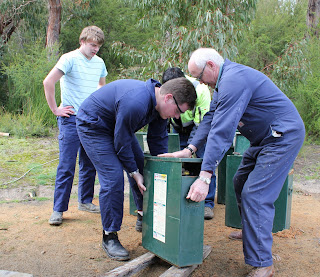 |
| The students begin disassembling everything |
 |
| Jerry checks the connections to our new smart regulator |
Jerry is an experienced solar installer with wide experience in solar and small wind installations. He also teaches an off grid renewable energy course at Swinburne TAFE, and used our job as a practical exercise for his students. This meant that all work was of the highest standard and we were able to “sit in” on the teaching which allowed us to expand our knowledge at the same time. Many thanks to Jerry and his students for their excellent work.
Over 2 days we:-
• Moved the batteries and inverter into the back part of our workshop, which is attached to the house. This is a much better location because the batteries are protected from the elements (rain, sun, humidity) and are subject to a more or less constant temperature. As the workshop is part of our house they are also more secure and we no longer have to pay extra on our insurance policy because they are now covered by our contents policy.
 |
| Those batteries are heavy! |
• Built a battery box to house the batteries. This prevents unauthorised access to batteries and allows any fumes to be exhausted through a vent in the wall to the outside.
• Laid new thicker cable underground to carry the DC current from the solar panels down to the house
• Reconfigured the solar panel connections so they are now arranged in 3 panels per string (480w each) with a voltage of 110v DC. The higher voltage and thicker cable reduces losses in the system.
 |
| Reconfiguring the panel connections |
 |
| Making full use of the machine! |
• Installed an Outback maximum power point tracking (MPPT) or smart solar regulator. Our old regulator was a very basic “not very smart” device. Our new regulator is programmable and can monitor current flows to maximise solar gain in the system. It also allows us to program regular equalisation charges and provides a host of extra readouts including a 180 day history of how much power has gone into the batteries
• Upgraded all connections to current installation standards. Our initial setup was done prior to solar becoming “mainstream” and before installation standards had been set at a high level. The previous system had a proliferation of wires, little to no labelling and minimal protection fuses in the system. Jerry ensured this was all rectified, leaving everything clearly labelled and neatly set out.
• While we had the machinery here, we took the opportunity to run underground 240v cabling to our new garage for power points and lighting. We also installed a large pipe under the drive so that we can direct water from both sides of the driveway into our dam.
 |
| The new setup |
We thoroughly recommend Jerry if you have the need for someone experienced in alternative energy installations . Apart from the quality of his work, he is happy to work within a budget, can sometime’s source quality second-hand equipment and is happy for clients to contribute some of the labour to reduce costs. Although based in Healesville, he does installations all over the state.
When getting quotes for a renewable energy system, there are huge benefits in choosing an installer with whom you can form a working relationship. Someone who not only has the expertise, but uses quality components, is reliable and whom you can call on for help if necessary. If you go for the cheapest quote or one of the larger alternative energy companies you may not get this.


































